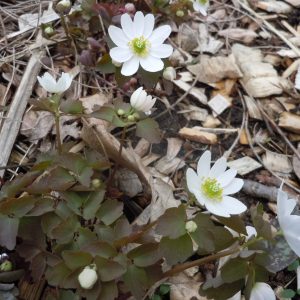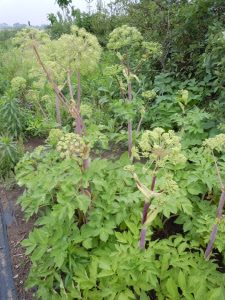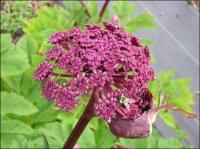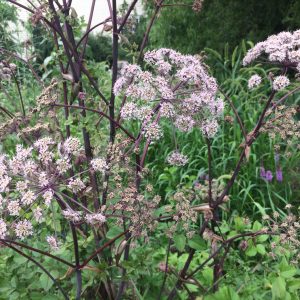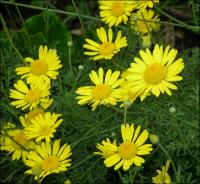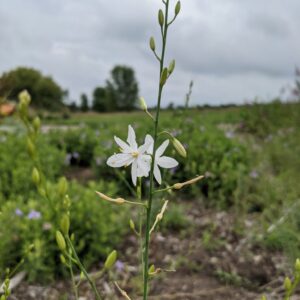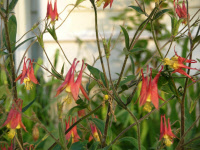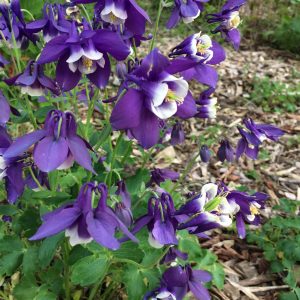Our Plants
Showing 41–48 of 587 results
-
Anemonella thalictroides Rue anemone, Windflower Z 4-7
Delicate white to pinkish cups in spring to mid-summer light up woodlands
OUT OF STOCK
Delicate white to pinkish cups in spring to mid-summer light up woodlands
Size: 8" x 8"
Care: part shade in moist well drained soil
Native: N.H through Ontario to Minn. including Wisconsin, south to Florida & KansasFirst described by Linnaeus – 1753. Englishman Philip Miller grew this in 1768. Named Anemonella because the flowers resemble those of the Amenome and thalictroides because the leaves resemble the leaves of the Thalictrum, Meadowrue. Native Americans ate the tuberous root for food and made a tea from Rue anemone by steeping the root in water. The tea supposedly cured flu-like symptoms of diarrhea and vomiting.
-
Angelica archangelica Biennial Z 4-9
Spectacular chartreuse globular umbels
Spectacular chartreuse globular umbels of flowers in July
Size: 6’ x 3’
Care: sun in moist to moist well-drained soil
Native: Russia, ScandinaviaAngelica is Latin for “angelic,” because an angel is said to have revealed to a monk that the plant cures the plague. Ancient – used medicinally for more than 2000 years. Used to flavor reindeer milk in Scandinavia, to flavor perfume & liqueurs, and to make a French delicacy of candied stalks. Add fresh leaves to your salad or make a tea from dried leaves. Folklore claims it has angelic healing properties. Introduced to England in 1625 by Tradescant the Elder who collected it on the island of Archangel in Russia.
-
Angelica gigas Giant angelica RESEEDING BIENNIAL Z 4-9
Dramatic, deep purple, spherical umbels in midsummer, purple stems
Dramatic, deep purple, spherical umbels in midsummer, purple stems.
Size: 4-6' x 4'
Care: full sun to part shade in moist well-drained soil. Be sure to let the flowers drop its seeds and do not weed the seedlings out the following spring. It reseeds readily from fresh seed.
Native: mountain streams in Korea
Wildlife Value: Butterfly plant, attracts baldfaced hornets (actually wasps) who are so busy collecting nectar that they ignore people. Deer resistantAngelica: Latin for “angelic,” because an angel is said to have revealed to a monk that the plant cures the plague but, according to Miller (1768), it means “from the angels, on account of its excellent qualities.” This species 1st collected by Japanese botanist Takenoshin Nakai before 1917. (1882-1952) professor, author, scholar and official botanist for Korea in 1910 after Japan annexed Korea following the Sino-Japanese and Russo-Japanese wars. He explored the botanically unknown mountains and forests and introducing its plants to the world through his international contacts and authorship of Flora Koreana. Used in its native Korea to remedy “anaemia, hemiplegia and women’s diseases.” Korean name is Cham-dang-gui.
-
Angelica sylvestris ‘Purpurea’ Wild Angelica Self-seeding Biennial Z 4-9
Imposing, glossy, deep purple stems and buds with large umbels of mauve to dusky pink to purplish late summer-early fall.
Imposing, glossy, deep purple stems and buds with large umbels of mauve to dusky pink to purplish late summer-early fall.
Can not ship to : Maine
Size: 5-6' x 5'
Care: sun to part shade in moist to moist well-drained soil. Be sure to let the flowers drop its seeds and do not weed the seedlings out the following spring. It reseeds readily from fresh seed
Native: Europe in moist woodlands and bogs.
Wildlife Value: attracts bees and butterfliesFresh stems or boiled leaves eaten medicinally to cure scurvy. In Austria made into a tea to remedy infections, flu, stomach ailments and respiratory ailments. The species described in Species Plantarum 1: 251. 1753 (1 May 1753) by Linnaeus. William Jackson Hooker described the wild species growing in England as having “stem purplish, pubescent above, as well as the umbels.” The British Flora p. 180 (1860)
-
Anthemis tinctoria Marguerite
Cheerful yellow daisies all summer, non-stop.
Cheerful yellow daisies all summer, non-stop.
Size: 2-3' x 2'
Care: Full sun well-drained to moist well-drained soil, drought tolerant
Native: Eastern EuropeThis promiscuous flower sports maize colored daisies with ferny, aromatic foliage. The name Anthemis evolved from anthemon meaning “free flowering,” which describes the plant’s carefree, June through fall, blossoms. Philip Miller illustrated Marguerite in his 1750’s Dictionary. The flower was used to dye wool and to make tea.
-
Anthericum ramosum Spider plant, Branched St Bernard’s-lily Z 5-8
White, branched flower clusters above grass-like leaves June-August
OUT OF STOCK – EMAIL FOR AVAILABILITY
White, branched flower clusters above grass-like leaves June-August
Size: 2-3’ x 12”
Care: full sun in well-drained soil
Native: Western, Central & Southern Europe
Wildlife Value: Attracts bees, butterflies and hummingbirdsPublished by Linneaus in Species Plantarum (1753)
-
Aquilegia canadensis Canada Columbine Z 3-9
In May and June yellow petticoats peek out from under eye-popping red skirts flaring at the ends as these flowers dangle from tall stems.
In May and June yellow petticoats peek out from under eye-popping red skirts flaring at the ends as these flowers dangle from tall stems.
Size: 24-36”x 12”
Care: part shade in moist well-drained soil - moist in spring & dry in summer
Native: Eastern Canada to Florida, west to New Mexico, Wisconsin native.
Wildlife Value: Provides rich, early spring nectar for bumblebees, bees, butterflies, and hummingbirds. Buntings and finches eat seeds. Sole food source for Columbine duskywing caterpillar.
Awards: England’s Royal Horticultural Society Award of Merit.Seeds are fragrant when crushed, used by Omaha, Ponca and Pawnee as perfume. Pawnee used the plant as a love charm by rubbing pulverized seeds in palm of hand and endeavoring to shake hand of desired person. Crushed seeds also used to cure fever and headaches. Cherokee made a tea for heart trouble. The Iroquois used the plant to cure poisoning and to detect people who were bewitched. Grown by Tradescant the Elder in England in 1632. He may have received it from France. Cultivated by Washington & Jefferson. Grown at America’s 1st botanic garden, Elgin Botanic Garden 1811.
-
Aquilegia flabellata v. pumila syn. Aquilegia flabellata ‘Nana’, Aquilegia fauriei Dwarf Fan columbine Z 4-9
April-May lilac blooms of nodding lilac-blue to purple sepals with white petals on compact mound of blue-green foliage
OUT OF STOCK
April-May lilac blooms of nodding lilac-blue to purple sepals with white petals on compact mound of blue-green foliage
Size: 6-9” x 9-12”
Care: sun to part shade in moist well-drained soil, Deadhead for rebloom
Native: Japan
Wildlife Value: deer and rabbit resistant. Attracts butterfliesLatin word flabellatus mean fanlike referring to leaflet shape. First published as Aquilegia buergeriana var. pumila in Swiss journal Bulletin de l’Herbier Boissier 5: 1090. 1897.

